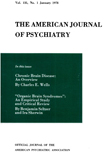Some Relations Among Psychiatric Symptoms, Organic Illness, and Social Class
Abstract
Two major investigations of the prevalence of psychiatric disorder in community groups, the Midtown and Stirling County studies, relied heavily on symptoms the researchers considered psychophysiological. Both found the highest rates of psychiatric disorder in the lowest status groups. The present study of a sample of 1,710 adults in Washington Heights, New York City, indicates that the previous findings are in part a function of a distinct tendency for lower-class groups to express psychological distress in physiological terms. The present results also suggest that the higher rates are confounded with organic illness.
Access content
To read the fulltext, please use one of the options below to sign in or purchase access.- Personal login
- Institutional Login
- Sign in via OpenAthens
- Register for access
-
Please login/register if you wish to pair your device and check access availability.
Not a subscriber?
PsychiatryOnline subscription options offer access to the DSM-5 library, books, journals, CME, and patient resources. This all-in-one virtual library provides psychiatrists and mental health professionals with key resources for diagnosis, treatment, research, and professional development.
Need more help? PsychiatryOnline Customer Service may be reached by emailing [email protected] or by calling 800-368-5777 (in the U.S.) or 703-907-7322 (outside the U.S.).



